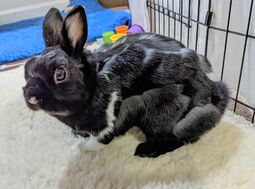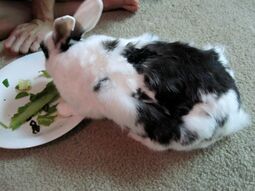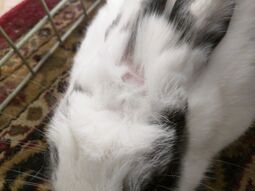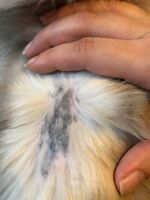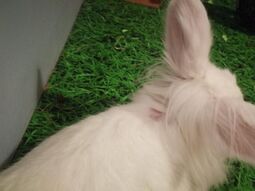Fur loss
Fur loss or hair loss, also known as alopecia, in rabbits can be caused by both natural reasons as well as disorders.
Symptoms
- A complete or partial lack of hair where it is normally present.
Alopecia may be associated with a multiple causes and may be the primary problem or a secondary phenomenon.
Causes
Causes of alopecia can range from normal reasons to behavioral, parasitic, hormonal , and more.
- Behavioral
When a rabbit is housed with other rabbits, dominant cage mates may chew or pull out fur of the submissive rabbits. Overzealous groomers may also cause bond mates to go bald. See Overgrooming for more details.
- Cancerous
Cancers such as thymoma, cutaneous lymphoma and mast cell tumor can cause fur loss in rabbits.[1]
- Hormonal
Nesting females may pull fur from their dewlaps and stomachs. See Pseudopregnancy and Pregnant rabbits for more details.
- Immunologic
Contact dermatitis and sebaceous adenitis can cause fur loss.
- Infection
Bacterial skin infections and ringworm may also cause fur loss. These often occur as a secondary problem for other issues, especially moist dermatitis.[1]
- Molting
Molting is a natural process that occurs 2-3 times a year where a rabbit sheds their entire old coat to expose the new. It usually occurs twice a year during spring and fall.[2] Rabbits lose their first coat at about four months of age, depending on the breed.[3] Changes in environment temperature from hot and cold weather are usually onsets of molting. Bald spots are common at this time, and fur should start to grow in within 7-10 days.[4] It is also common for a "tide mark" to develop with obvious delineations of old and new fur as the rabbit molts. Some breeds, especially dwarf, miniature lop, and angora rabbits may lose their hair in patches.[1] Owners may also see patches of black or dark-looking skin as the fur grows back.
Owners should regularly groom their rabbits to minimize the amount of hair that the buns can ingest to prevent hairballs and GI stasis from occurring. Make sure that your rabbit is consuming appropriate amounts of hay and other roughage as well as water to keep their digestive tract free of fur.
The links below provide more information about molting.
- Esther van Praag. Varying shedding patterns among rabbits
- Rabbit Welfare Fund. (2016). Moulting
- Nutrition
An improper diet with insufficient nutrition, particularly protein deficiencies, can cause alopecia in rabbits. The fur is often a reddish and thin in malnourished rabbits.
- Sore hocks
Rabbits may lose fur on their feet due to sore hocks. See the linked article for more details.
Diagnosis
- Symmetrical fur loss is often a sign of barbering. A close examination reveals broken hairs.
- Fur mites are usually cause fur loss between the shoulders or in the tail base region. Dandruff-like white scales can be seen in the hair as well. Mites are easily identified with a skin scraping or acetate tape preparation performed by your veterinarian.
- Ear mites cause alopecia around the ear base that may extend to the rest of the body depending on severity. The skin will be red and swollen, and brown and beige crusty material can be found in the ear canal and inner ear.
- Fleas cause patchy fur loss, and finding "flea dirt" can help to differentiate. Sometimes, there may also be a secondary skin infection.
- Burrowing mites such as Sarcoptes scabiei and Notoedres cati that cause mange rarely infest rabbits. Areas of damage are located around the head and neck and are intensely itchy.
- Injection reactions can cause fur loss, flakes, and redness around the injection site.
- Lack of grooming may cause alopecia and an accumulation of flakes between the shoulders or in tail base region.
- Contact dermatitis can cause fur loss with or without redness, flakes on lower belly or other contact areas.
- Moist dermatitis can cause alopecia with or without redness, flakes, or ulceration. Facial fur loss is associated with runny eyes or drooling; fur loss in the ventral area is associated with urinary disease, diarrhea, or uneaten cecotrophs.
- Ringworm cause partial to complete alopecia with flaking and with or without redness. However, fur loss is not always ringlike and may begin as small raise spots.
- Syphilis causes fur loss along with crusts in areas like the nose, lips, and genitalia.
- Cancerous reasons such as cutaneous lymphoma, cutaneous epitheliotropic lymphoma (mycoses fungoides) or mast cell tumors are rare in rabbits, but they may cause alopecia, flaking, and redness in spots or all over the body. Similar lesions may occur in association with thymoma and sebaceous adenitis in some rabbits.
Treatment
Treatment will be specific to the underlying cause. Normal natural molting will not require any treatment. See linked articles for details.
Further reading
- Dana Krempels, Ph.D., Fur Loss and Skin Problems in Rabbits: Common Causes and Treatment
- PetMD, Hair Loss in Rabbits
- House Rabbit Society, Kathleen Wilsbach, Ph.D., Skin Diseases in Rabbits: Common Causes, Common Treatments
- MediRabbit, Esther van Praag, Ph.D., Hair loss (alopecia) in rabbits
- Angie Pollock, Fur loss in rabbits: Causes and treatments
- Verlannahill Rabbitry, John W. Jones, Rabbit Molting and Hair Loss
- Buckeye House Rabbit Society, Dr. Robert Nathan, Skin Disorders in Rabbits
- Stephen D. White, DVM, DACVD; Patrick J. Bourdeau, DV, DECVD; and Anna Meredith, MA, VetMB, CertLAS, CertZooMed, MRCVS; Dermatologic Problems of Rabbits
- Provet, Causes of Hair Loss in Rabbits
- Burgess Pet Care, Dermatology of Small Mammals
- AEMVvets (Instagram), Barbering in exotic companion mammals
See also
References
- ↑ 1.0 1.1 1.2 Oglesbee, B. (2011). Blackwell's Five-Minute Veterinary Consult: Small Mammal. (2nd ed.).
- ↑ Quesenberry, K & Carpenter, J. (2012). Ferrets, Rabbits, and Rodents: Clinical Medicine and Surgery. (3rd ed.).
- ↑ Parent, L.E & Vriends, M. (1989). The New Rabbit Handbook.
- ↑ Harcourt-Brown, F. (2001). Textbook of Rabbit Medicine. (1st ed.).


